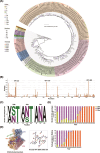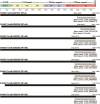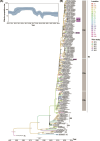Transition of D3c branch and novel recombination events contribute to the diversity of Coxsackievirus A6 in Beijing, China, from 2019 to 2023
- PMID: 40574752
- PMCID: PMC12202042
- DOI: 10.1093/ve/veaf036
Transition of D3c branch and novel recombination events contribute to the diversity of Coxsackievirus A6 in Beijing, China, from 2019 to 2023
Abstract
Coxsackievirus A6 (CVA6) is a major pathogen responsible for numerous outbreaks of hand, foot, and mouth disease (HFMD) worldwide. This study investigates the molecular evolution and recombination of CVA6 in Beijing, China. Full-length sequences of 54 CVA6 from Beijing (2019-2023) were obtained through metagenomic next-generation sequencing and Sanger sequencing. These sequences were compared with representative sequences from GenBank to analyse their phylogenetic characteristics, recombination diversity, and evolutionary dynamics. The 54 CVA6 strains co-circulated with those from multiple provinces in China, as well as from South Korea and Japan. Phylogenetic analysis revealed a novel D3c branch, with the VP1 T283A amino acid mutation identified as a key change in its formation. One sequence belonged to the D3a branch, while 53 sequences belonged to the D3c branch. Recombination analysis identified RF-A (46, 85.1%) and three novel recombinant forms (RFs): RF-Z (1, 1.9%), RF-AA (1, 1.9%), and RF-AB (6, 11.1%). Bayesian phylogenetic analysis estimated that the most recent common ancestor of D3c emerged in August 2013 (95% highest probability density (HPD): May 2012 to September 2014), with recombination events occurring in RF-Z (2017-2019), RF-AA (2019-2023), and RF-AB (2021-2023). In conclusion, we revealed a globally circulating CVA6 D3c branch and identified three novel RFs, providing valuable insights for the intervention and control of HFMD.
Keywords: Coxsackievirus A6 (CVA6); hand, foot, and mouth disease (HFMD); metagenomic next-generation sequencing; novel D3c branch; recombinant forms (RFs).
© The Author(s) 2025. Published by Oxford University Press.
Figures






Similar articles
-
Phylogenetic analysis of the VP1 coding region of CVA6 detected in hand-foot-and-mouth disease during surveillance from 2019 to 2024 in Japan.Jpn J Infect Dis. 2025 Jul 31. doi: 10.7883/yoken.JJID.2025.039. Online ahead of print. Jpn J Infect Dis. 2025. PMID: 40738663
-
The Emergence of Coxsackievirus A16 Subgenotype B1c: A Key Driver of the Hand, Foot, and Mouth Disease Epidemic in Guangdong, China.Viruses. 2025 Feb 3;17(2):219. doi: 10.3390/v17020219. Viruses. 2025. PMID: 40006974 Free PMC article.
-
Recent advances on coxsackievirus A6 vaccine research.Front Immunol. 2025 Jun 6;16:1603028. doi: 10.3389/fimmu.2025.1603028. eCollection 2025. Front Immunol. 2025. PMID: 40547039 Free PMC article.
-
Seroprevalence of coxsackievirus A6 and enterovirus A71 infection in humans: a systematic review and meta-analysis.Arch Virol. 2023 Jan 7;168(2):37. doi: 10.1007/s00705-022-05642-0. Arch Virol. 2023. PMID: 36609748 Free PMC article.
-
A single amino acid mutation in VP1 of coxsackievirus A6 determining efficiency of VP0 cleavage and proliferation.J Virol. 2025 Jun 17;99(6):e0012825. doi: 10.1128/jvi.00128-25. Epub 2025 May 14. J Virol. 2025. PMID: 40366174 Free PMC article.
References
Associated data
LinkOut - more resources
Full Text Sources

